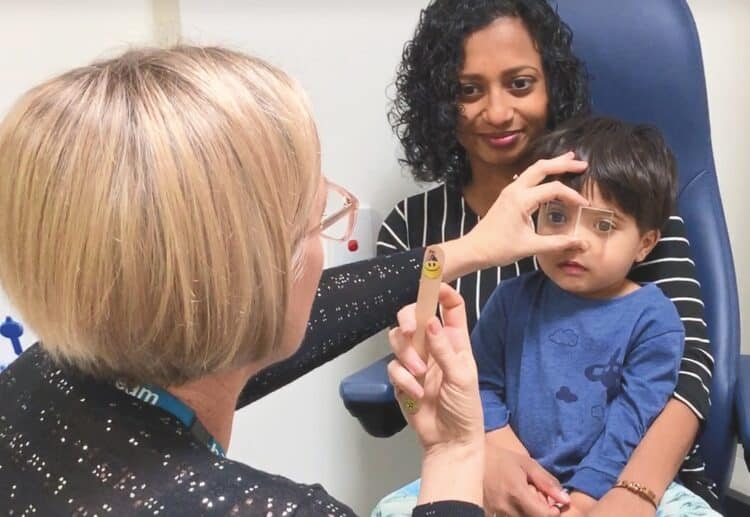Paediatric ophthalmic conditions are often complex and can require lengthy investigations over many years. As the demand for paediatric eyecare increases, orthoptists are taking a lead role in adapting service delivery to ensure children have access to appropriate care in a clinically appropriate timeframe.

These models of shared care benefit all stakeholders, the patients, the RCH, our collaborative partners,and student learning, which in turn benefits future community care.
Traditional approaches to paediatric eye care are provided by orthoptists and ophthalmologists through public hospital outpatient eye clinics. However, due to tight budgets and fixed clinic space, staff recruitment and clinic expansion are rarely an option to improve access to care in public hospital outpatient eye clinics.
As such orthoptists are identifying opportunities for collaboration which can result in improved, affordable, patient focused and clinically appropriate care.
In 2020, with the support the director of ophthalmology at The Royal Children’s Hospital (RCH) in Melbourne, a collaboration between the RCH orthoptic team and orthoptists in the La Trobe University Orthoptics Department resulted in the establishment of the orthoptic student led Latrobe University Eye Clinic (LTEC). RCH patients with strabismus and/or amblyopia who met the referral criteria were referred into the orthoptist managed pathway of shared care.
Following the success of shared care with LTEC, director of ophthalmology, Dr Anu Mathew and I explored additional opportunities for collaboration to provide and maintain a sustainable model of paediatric eyecare provision.
A second collaboration was established with the optometry student led Melbourne Eyecare Clinic (MEC), which is linked to the Melbourne University School of Optometry. In this pathway of shared care, RCH patients with craniosynostosis, juvenile infantile arthritis, NLDO and chalazion who met the referral criteria were referred into the MEC.
Although different patient groups were involved with each collaboration, the process of establishing and implementing the pathways of care were the same. Patients were managed according to the evidence-based RCH guidelines, and additional protocols relating to patient care and administrative workflow were developed collaboratively for each pathway of shared care. Patient surveys and quality control audits have shown both models of collaborative care are patient focused and provide timely and appropriate care.
Collaboratively managing over 1,000 children in the community has had the added benefit of improving access to care within the RCH eye clinic for children with complicated conditions unable to be managed externally.
These models of shared care benefit all stakeholders, the patients, the RCH, our collaborative partners, and student learning, which in turn benefits future community care. Yet at RCH, we continue to struggle to reduce outpatient waitlist numbers and patient access. Additional education, collaboration and community-based paediatric eyecare is essential to meet demand.
The RCH Ophthalmology Department is developing online paediatric ophthalmic education resources to build and support relationships with optometrists in the community who are interested in providing evidence based, paediatric ophthalmic care both independently and in collaboration.
Projects of this scale are not possible without financial support, and therefore Dr Anu Mathew, and I were honoured to be the 2024 recipients of the RCH Foundation, Frank Billson Research Scholarship. This scholarship was awarded to support the development and implementation of online education and collaboration modules.
An online module containing paediatric ophthalmic collaborative-care resources is being developed for optometrists in the local community interested in collaborative care with RCH.
A separate online education module is simultaneously being developed to support optometrists locally and nationally, who are interested in further developing their knowledge and skillset in the field of paediatric ophthalmology. This module will include information on paediatric ophthalmic assessment, and diagnosis and management of paediatric ophthalmic conditions.
To ensure content meets end user requirements, all optometrists in the community are invited to provide feedback by completing a short anonymous survey. To participate in the survey, please scan the QR code at the end of this article. Participation is strongly encouraged to enable development of appropriate educational resources aimed to support regional, metropolitan, and remote based optometrists in both clinical and non-clinical roles, with a wide range of experience and knowledge in the field of paediatric ophthalmology.
Thank you in advance for your participation, and we look forward to providing an update on the project in the near future.
About the Author: Cathy Lewis is the chief orthoptist at The Royal Children’s Hospital in Melbourne and a casual lecturer in orthoptics at Latrobe University. She has over 30 years’ experience working and volunteering as an orthoptist both locally and abroad and has co-developed and implemented several initiatives at the RCH to improve access to patient centred care.
More reading
An orthoptist’s journey into Alice Springs
Diabetic retinopathy in Indigenous Australians
Re-writing the rules of dry eye management




